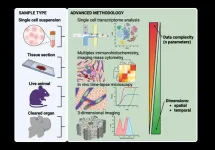(Press-News.org) Pollinosis, or hay fever, makes people miserable around the world, and Japanese cedar (Cryptomeria japonica) pollen is a significant cause of the suffering in the 38.8% of Japanese people who are allergic. Japanese cedar is also the country's most important timber species. A single mature tree produces on the order of three hundred million grains of pollen. Saneyoshi Ueno and colleagues investigated the genes required to produce this massive amount of genetic material. Previous research by Ueno’s team identified a gene, CJt020762, that seems to be required for pollen production. Mutants who carry broken versions of the gene make no pollen at all. Now, another gene, CjTKPR1, found in a different locus, is also determined to be necessary for the production of pollen. Functionally, CjTKPR1 is required for construction of the wall of the pollen grain. Mutant trees with nonfunctional versions of this gene already exist and produce nearly no pollen. Knocking out this gene in the model plant Arabidopsis thaliana, rice, tobacco, and daisies led to male sterility in each case. According to the authors, creating pollen-free commercially grown timber tree lines would be straightforward and desirable.
END
Creating pollen-free trees to combat hay fever
2023-08-08
ELSE PRESS RELEASES FROM THIS DATE:
SwRI launches Engine for Automatic Biomechanical Evaluation (ENABLE™) markerless analysis tool
2023-08-08
SAN ANTONIO — August 8, 2023 – Southwest Research Institute is launching its new Engine for Automatic Biomechanical Evaluation (ENABLE™) markerless biomechanics system during the American Society of Biomechanics (ABS) Annual Conference, August 8-11, in Knoxville, Tennessee. ABS attendees can see a demonstration by visiting Booth No. 11.
ENABLE is a user-friendly markerless motion capture system that leverages artificial intelligence, computer vision algorithms and biomechanical modeling. The key advantage of ENABLE is it efficiently captures ...
Spatial dimension of macrophage heterogeneity in liver diseases
2023-08-08
This review manuscript highlights the relevance of spatially-resolved macrophage phenotyping in liver disease-related research.
The liver is a vital organ heavily populated with macrophages, which represent key players of the innate immune response but also hold key functions in the maintenance of a healthy organ. Liver macrophages are mostly distributed across two populations of different origins and functions during homeostasis and disease: liver resident macrophages (referred to as Kupffer cells, KCs), and monocytic macrophages derived from the bone-marrow (MoMFs). The KC: MoMF ratio, as well as their respective spatial distribution through the liver, are increasingly ...
Host adaptation drives genetic variation in Lyme disease bacteria
2023-08-08
A study looks at the mechanisms behind genetic variation in the bacteria that cause Lyme disease. Lyme disease is the most common vector-transmitted disease in the United States, with around 476,000 human cases annually. Most Lyme disease is caused by the bacteria Borrelia burgdorferi (Bb), which is transmitted by ticks and can infect a wide range of mammals and birds. Matthew Combs and colleagues analyzed the genetic diversity of Bb, specifically focusing on the pathogen’s outer surface protein C (ospC) gene, a well-known virulence factor that is essential for survival of the pathogen inside the tick and the early stages of infection in vertebrates. ...
Antimicrobial resistance poses threat in all 35 countries in the Americas
2023-08-08
***Embargo 14:00 UK / 10:00 BRT / 9:00 ET / 6:00 PT Tuesday, August 8, 2023***
SEATTLE, Wash. August 8, 2023 – 569,000 deaths were linked to bacterial antimicrobial resistance (AMR) in all 35 countries of the WHO Region of the Americas, according to a new peer-reviewed paper published in The Lancet Regional Health – Americas. This analysis on the burden of AMR in the Americas is the most comprehensive yet for the region, providing data for 35 countries, 23 bacterial pathogens, and 88 pathogen-drug combinations.
The ...
Parenting a 3-year-old robot
2023-08-08
Humans are social creatures and learn from each other, even from a young age. Infants keenly observe their parents, siblings or caregivers. They watch, imitate and replay what they see to learn skills and behaviors.
The way babies learn and explore their surroundings inspired researchers at Carnegie Mellon University and Meta to develop a new way to teach robots how to simultaneously learn multiple skills and leverage them to tackle unseen, everyday tasks. The researchers set out to develop a robotic AI agent with manipulation abilities equivalent to a 3-year-old child.
The team has announced RoboAgent, an artificial intelligence agent that leverages passive observations and active ...
Study compares youth detained for sex trafficking with more serious offenders
2023-08-08
Every year in the United States, about 1.7 million youth run away from home, which places them at risk for sex trafficking and prostitution. Sadly, most youth tend to fall victim to sex trafficking between the ages of 12 to 14.
While federal and state laws have been enacted to protect these runaway youth, they continue to be arrested, charged and detained for prostitution. Detaining youth who should not legally be considered offenders and who have extensive histories of victimization and mental health issues only exacerbates their underlying vulnerabilities that may have led them to run away or be sexually exploited in the first place.
There is ...
Insilico Medicine joins Montreal Chamber of Commerce to drive continued innovation
2023-08-08
Insilico Medicine (“Insilico”), a clinical stage generative artificial intelligence (AI) drug discovery company, has announced that it is now a member of the Chamber of Commerce of Metropolitan Montreal, demonstrating its commitment to the vibrant business community of Montreal and to fostering economic growth in the region. Insilico will officially launch its AI R&D Center in Montreal later this fall.
As a new member of the Chamber of Commerce of Metropolitan Montreal, Insilico brings its innovative expertise ...
'Crushing' chemical innovations at the heart of newly expanded NSF Center
2023-08-08
NEW YORK, August 8, 2023 — CUNY ASRC researcher Adam Braunschweig’s lab is part of a newly awarded $20 million center from the U.S. National Science Foundation to understand the atomic-scale mysteries of "crushing" chemistry. The multi-institutional award will establish the Center for the Mechanical Control of Chemistry (CMCC), which will conduct work to understand how the mechanical application of force can enable new advances in chemistry and make industrial processes cheaper and more environmentally friendly.
“I’m excited that my lab is playing a part in research ...
Bighorn sheep associations: understanding tradeoffs of sociality and implications for disease transmission
2023-08-08
Sociality plays a pivotal role in the lives of many animal species, influencing mating success, survival rates, and susceptibility to diseases. In the challenging environment of bighorn sheep populations, sociality is believed to have evolved for its fitness benefits. However, the delicate balance of costs and benefits associated with sociality can vary at different scales, leading to diverse interpretations of animal behavior.
New research titled "Bighorn sheep associations: understanding tradeoffs of sociality and implications for disease transmission" has been published in PeerJ Life & Environment. The study, ...
Lead poisoning from Ayurvedic medicines: rare but cautionary
2023-08-08
An article in CMAJ (Canadian Medical Association Journal) highlights a case of lead toxicity from Ayurvedic medicines in a young woman, and the complexity in diagnosing the rare condition https://www.cmaj.ca/lookup/doi/10.1503/cmaj.230592.
"Given that lead toxicity is uncommon and its presentation nonspecific, patients are often seen by many health care providers before the diagnosis is made," writes Dr. Julian Gitelman, Dalla Lana School of Public Health, University of Toronto, with coauthors. "A careful exposure history is essential to suggest the diagnosis."
The patient, a 39-year-old woman, visited the emergency department 3 times in 6 weeks ...






